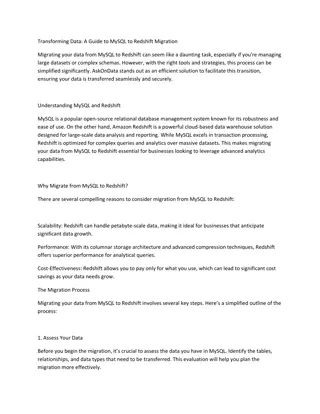Connecting to MySQL Database Using PHP MySQL Improved Extension
Learn how to connect to a MySQL database using the mysqli class in PHP. Understand the connection requirements, implement examples for connecting to the server and executing queries, and handle errors effectively when interacting with the database.
Download Presentation

Please find below an Image/Link to download the presentation.
The content on the website is provided AS IS for your information and personal use only. It may not be sold, licensed, or shared on other websites without obtaining consent from the author. Download presentation by click this link. If you encounter any issues during the download, it is possible that the publisher has removed the file from their server.
E N D
Presentation Transcript
MySQL Web Application Connecting to a MySQL database Building and Executing a Query Implement three examples
mysqli class for Connecting to a MySQL Database To access the data on a MySQL server, a connection to that server must be created. mysqli is a class that uses a data object to establish that connection. mysqli is an extension of MySQL and is short for MySQL Improved. mysqli is a relational database driver used in the PHP programming language to provide an interface with MySQL databases.
Connection Requirements Parameter $servername - Specifies the server to connect to. NOTE: If you pass the NULL value or an empty string "", the server will use the default value: "localhost - $username - Specifies the MySQL username to log in with. NOTE: Default value is the name of the user that owns the server process - $password - Specifies the password to log in with. - $database - Specifies the database to be used when performing queries. - $port - server. Specifies the port number to attempt to connect to the MySQL NOTE: The default port is 3306
Example <?php // TASK 1: CONNECT TO THE SERVER $mysqli= new mysqli($servername, $username, $password, $database, $port); // TASK 2: CHECK IF THERE IS AN ERROR CONNECTING. //Mysqli_connect_errno() WILL RETURN AN ERROR CODE. if (mysqli_connect_errno()) { exit('Connect failed: '. mysqli_connect_error()); } //TASK 3: CLODE THE CONNECTION $mysqli->close(); ?>
PHP Documentation Site Example <?php // Connecting to and selecting a MySQL database named sakila // Hostname: 127.0.0.1 $mysqli = new mysqli('127.0.0.1', $username, $password, sakila ); // Check if a connect_errno exists, causing a connection attempt to fail. if ($mysqli->connect_errno) { // The connection failed. What do you want to do? // You could contact yourself (email?), log the error, show a nice page, etc. // You do not want to reveal sensitive information echo "Sorry, this website is experiencing problems."; // Something you should not do on a public site, but this example will show you // anyways, is print out MySQL error related information -- you might log this echo "Error: Failed to make a MySQL connection, here is why: \n"; echo "Errno: " . $mysqli->connect_errno . "\n"; echo "Error: " . $mysqli->connect_error . "\n"; // In case of an error, exit exit; }
Perform an SQL Query $sql = "SELECT actor_id, first_name, last_name FROM actor WHERE actor_id = $aid"; if (!$result = $mysqli->query($sql)) { //Respond to a failed query. echo "Sorry, the website is experiencing problems."; // get the error information echo "Error: Our query failed to execute: \n"; echo "Query: " . $sql . "\n"; echo "Errno: " . $mysqli->errno . "\n"; echo "Error: " . $mysqli->error . "\n"; exit; }
Fetch the result of SQL Query // Our MySQL connection and query succeeded, but do we have a result? if ($result->num_rows === 0) { echo "We could not find a match, sorry about that. Please try again."; exit; } // Fetch the result into an associated array where the array's keys are the // table's column names $actor= $result->fetch_assoc(); echo "Sometimes I see " . $actor['first_name'] . " " . $actor['last_name'] . " on TV."; // Fetch five random rows and output their names to a list. $sql = "SELECT actor_id, first_name, last_name FROM actor ORDER BY rand() LIMIT 5"; if (!$result = $mysqli->query($sql)) { echo "Sorry, the website is experiencing problems."; exit; } // Print our 5 random names in a list, and link to each actor echo "<ul>\n"; while ($actor = $result->fetch_assoc()) { echo "<li><a href='".$_SERVER['SCRIPT_FILENAME']. "?aid=".$actor['actor_id']."'>\n"; echo $actor['first_name'] . ' ' . $actor['last_name']; echo "</a></li>\n"; } echo "</ul>\n";
Close a MySQL Connection // The PHP script will automatically free the result // and close the MySQL connection when it exits. //Perform this task as a precaution. $result->free(); $mysqli->close();
Lab12a: Display all Contact records <?php //TASK 1: MAKE A CONNECTION TO THE DATABASE, // DISPLAY ERROR FOR FAILED CONNECTIONS //TASK 2: BUILD A STRING CONTAININ A MYSQL INSTRUCTION. // SELECT ALL RECORDS //TASK 3: USE THE ESTABLISHED DATABASE CONNECTION TO // PROCESS THE DATABASE QUERY. STORE THE RESULTS IN A VARIABLE. // TASK 3: OUTPUT DATA FOR EACH ROW ?>
Lab12b: Construct a Query for all Records with a Specified First name <?php //TASK 1: MAKE A CONNECTION TO THE DATABASE //TASK 2: GET FIRST NAME FROM THE FORM //TASK 3: CONSTRUCT A QUERY FOR ALL RECORDS WITH A MATCHING FIRST NAME //TASK 4: DISPLAY ALL RECORDS FROM THE QUERY RESULT ?>
Lab12 c: Build a Table of Results to Send to JavaScript to display in HTML <?php //TASK 1: MAKE A CONNECTION TO THE DATABASE, // DISPLAY ERROR FOR FAILED CONNECTIONS //TASK 2: BUILD A QUERY STRING //TASK 3: PROCESS THE DATABASE QUERY. STORE THE RESULTS IN A VARIABLE. //TASK 4: BUILD A TABLE OF RESULTS IN A STRING ?>























